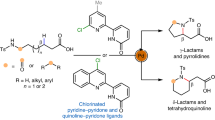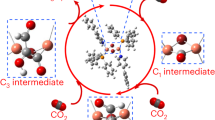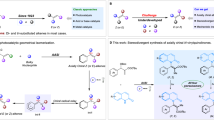Abstract
Continuous-flow synthesis of fine chemicals has several advantages over batch synthesis in terms of environmental compatibility, efficiency and safety. Nevertheless, most preparative methods still rely on conventional batch systems. For instance, chiral amines are ubiquitous functionalities in pharmaceutical compounds, but methods for their continuous synthesis with broad substrate generality remain very challenging. Here we show the development of heterogeneous iridium complexes combined with chiral phosphoric acids for the asymmetric hydrogenation of imines towards the continuous synthesis of chiral amines. Direct asymmetric reductive amination of ketones under a hydrogen atmosphere also proceeded smoothly using the same catalyst systems. Various chiral aromatic and aliphatic amines including pharmaceutical intermediates could be prepared in high yields with high enantioselectivities. It was found that continuous-flow reactions that use columns packed with the heterogeneous iridium complexes afforded chiral amines continuously for more than two days even at pressures lower than those in the corresponding batch reactions.
This is a preview of subscription content, access via your institution
Access options
Access Nature and 54 other Nature Portfolio journals
Get Nature+, our best-value online-access subscription
$29.99 / 30 days
cancel any time
Subscribe to this journal
Receive 12 digital issues and online access to articles
$119.00 per year
only $9.92 per issue
Buy this article
- Purchase on Springer Link
- Instant access to full article PDF
Prices may be subject to local taxes which are calculated during checkout





Similar content being viewed by others
Data availability
Other reaction procedures and characterization data of compounds are available in the Supplementary Information. All data is available from the authors on reasonable request.
References
Nugent, T. C. & El-Shazly, M. Chiral amine synthesis—recent developments and trends for enamide reduction, reductive amination, and imine reduction. Adv. Synth. Catal. 352, 753–819 (2010).
Kobayashi, S. Flow “Fine” synthesis: high yielding and selective organic synthesis by flow methods. Chem. Asian J. 11, 425–436 (2016).
Masuda, K., Ichitsuka, T., Koumura, N., Sato, K. & Kobayashi, S. Flow fine synthesis with heterogeneous catalysts. Tetrahedron 74, 1705–1730 (2018).
Geier, D., Schmitz, P., Walkowiak, J., Leitner, W. & Franciò, G. Continuous flow asymmetric hydrogenation with supported ionic liquid phase catalysts using modified CO2 as the mobile phase: from model substrate to an active pharmaceutical ingredient. ACS Catal. 8, 3297–3303 (2018).
Amara, Z. et al. Enabling the scale-up of a key asymmetric hydrogenation step in the synthesis of an API using continuous flow solid-supported catalysis. Org. Process Res. Dev. 20, 1321–1327 (2016).
Madarász, J. et al. A continuous-flow system for asymmetric hydrogenation using supported chiral catalysts. J. Flow. Chem. 1, 62–67 (2011).
Shi, L. et al. Development of a continuous-flow system for asymmetric hydrogenation using self-supported chiral. Catalysts. Chem. Eur. J. 15, 9855–9867 (2009).
Hopmann, K. H. & Bayer, A. Enantioselective imine hydrogenation with iridium-catalysts: reactions, mechanisms and stereocontrol. Coord. Chem. Rev. 268, 59–82 (2014).
Xie, J.-H., Zhu, S.-F. & Zhou, Q.-L. Transition metal-catalyzed enantioselective hydrogenation of enamines and imines. Chem. Rev. 111, 1713–1760 (2011).
Fleury-Brégeot, N., de la Fuente, V., Castillón, S. & Claver, C. Highlights of transition metal-catalyzed asymmetric hydrogenation of imines. ChemCatChem 2, 1346–1371 (2010).
Li, Q. et al. Chiral phosphine–phosphoramidite ligands for highly enantioselective hydrogenation of N-arylimines. RSC Adv. 5, 13702–13708 (2015).
Lindqvist, M. et al. Chiral molecular tweezers: synthesis and reactivity in asymmetric hydrogenation. J. Am. Chem. Soc. 137, 4038–4041 (2015).
Schramm, Y., Barrios-Landeros, F. & Pfaltz, A. Discovery of an iridacycle catalyst with improved reactivity and enantioselectivity in the hydrogenation of dialkyl ketimines. Chem. Sci. 4, 2760–2766 (2013).
Hou, C.-J., Wang, Y.-H., Zheng, Z., Xu, J. & Hu, X.-P. Chiral phosphine–phosphoramidite ligands for highly efficient Ir-catalyzed asymmetric hydrogenation of sterically hindered N-aryl imines. Org. Lett. 14, 3554–3557 (2012).
Zhou, S., Fleischer, S., Junge, K. & Beller, M. Cooperative transition-metal and chiral Brønsted acid catalysis: enantioselective hydrogenation of imines to form amines. Angew. Chem. Int. Ed. 50, 5120–5124 (2011).
Mršić, N., Minnaard, A. J., Feringa, B. L. & Vries, J. Gd Iridium/monodentate phosphoramidite catalyzed asymmetric hydrogenation of N-aryl imines. J. Am. Chem. Soc. 131, 8358–8359 (2009).
Tang, W. J. & Xiao, J. L. Asymmetric hydrogenation of imines via metal–organo cooperative catalysis. Synthesis 46, 1297–1302 (2014).
Tang, W. J. et al. Cooperative catalysis: combining an achiral metal catalyst with a chiral bronsted acid enables highly enantioselective hydrogenation of Imines. Chem. Eur. J. 19, 14187–14193 (2013).
Li, C. Q., Wang, C., Villa-Marcos, B. & Xiao, J. L. Chiral counteranion-aided asymmetric hydrogenation of acyclic imines. J. Am. Chem. Soc. 130, 14450–14451 (2008).
Huang, H., Zhao, Y., Yang, Y., Zhou, L. & Chang, M. Direct catalytic asymmetric reductive amination of aliphatic ketones utilizing diphenylmethanamine as coupling partner. Org. Lett. 19, 1942–1945 (2017).
Zhou, S. L., Fleischer, S., Jiao, H. J., Junge, K. & Beller, M. Cooperative catalysis with iron and a chiral bronsted acid for asymmetric reductive amination of ketones. Adv. Synth. Catal. 356, 3451–3455 (2014).
Villa-Marcos, B., Li, C. Q., Mulholland, K. R., Hogan, P. J. & Xiao, J. L. Bifunctional catalysis: direct reductive amination of aliphatic ketones with an iridium–phosphate catalyst. Molecules 15, 2453–2472 (2010).
Rubio-Pérez, L., Pérez-Flores, F. J., Sharma, P., Velasco, L. & Cabrera, A. Stable preformed chiral palladium catalysts for the one-pot asymmetric reductive amination of ketones. Org. Lett. 11, 265–268 (2009).
Li, C. Q., Villa-Marcos, B. & Xiao, J. L. Metal-bronsted acid cooperative catalysis for asymmetric reductive amination. J. Am. Chem. Soc. 131, 6967–6969 (2009).
Rueping, M., Bootwicha, T. & Sugiono, E. Continuous-flow catalytic asymmetric hydrogenations: reaction optimization using FTIR inline analysis. Beilstein J. Org. Chem. 8, 300–307 (2012).
Brenna, D., Pirola, M., Raimondi, L., Burke, A. J. & Benaglia, M. A stereoselective, catalytic strategy for the in-flow synthesis of advanced precursors of rasagiline and tamsulosin. Bioorg. Med. Chem. 25, 6242–6247 (2017).
Brenna, D., Porta, R., Massolo, E., Raimondi, L. & Benaglia, M. A new class of low-loading catalysts for highly enantioselective, metal-free imine reduction of wide general applicability. ChemCatChem 9, 941–945 (2017).
Altava, B., Burguete, M. I., Garcia-Verdugo, E. & Luis, S. V. Chiral catalysts immobilized on achiral polymers: effect of the polymer support on the performance of the catalyst. Chem. Soc. Rev. 47, 2722–2771 (2018).
Trindade, A. F., Gois, P. M. P. & Afonso, C. A. M. Recyclable stereoselective catalysts. Chem. Rev. 109, 418–514 (2009).
Tang, W. et al. Cooperative catalysis through noncovalent interactions. Angew. Chem. Int. Ed. 52, 1668–1672 (2013).
Waldeck, B. “The β1-selective adrenoceptor agonist dobutamine”: a fallacy being perpetuated. Chirality 23, 63–64 (2011).
Tuttle, R. R. & Mills, J. Method for increasing cardiac contractility. US patent 3987200 (1976).
Sagratini, G. et al. Synthesis and α1-adrenoceptor antagonist activity of tamsulosin analogues. Eur. J. Med. Chem. 45, 5800–5807 (2010).
Kim, Y. G., Kang, L. S., Ha, H. J., Ko, S. W. & Lee, W. K. Asymmetric formal synthesis of (–)-formoterol and (–)tamsulosin. Heterocycles 71, 2243–2248 (2007).
Niigata, K. & Fujikura, T. Sulfamoyl-substituted phenethylaminederivatives, their preparation, and pharmaceutical compositions, containing them. US patent 4731478 (1988).
Verkade, J. M. M. et al. Mild and efficient deprotection of the amine protecting p-methoxyphenyl (PMP) group. Tetrahedron Lett. 47, 8109–8113 (2006).
Miyamura, H., Suzuki, A., Yasukawa, T. & Kobayashi, S. Polysilane-immobilized Rh–Pt bimetallic nanoparticles as powerful arene hydrogenation catalysts: synthesis, reactions under batch and flow conditions and reaction mechanism. J. Am. Chem. Soc. 140, 11325–11334 (2018).
Zhao, D. B. & Ding, K. L. Recent advances in asymmetric catalysis in flow. ACS Catal. 3, 928–944 (2013).
Acknowledgements
This work was supported in part by a Grant-in-Aid for Scientific Research from JSPS, the University of Tokyo, MEXT (Japan), AMED and JST. We thank T. Maki (The University of Tokyo) for scanning transmission electron microscopy and energy dispersive X-ray spectrometry analyses.
Author information
Authors and Affiliations
Contributions
T.Y. and R.M. designed and performed the experiments. T.Y. conceived and designed the study. S.K. conceived, designed and directed the investigations and wrote the manuscript with revisions provided by T.Y and R.M.
Corresponding author
Ethics declarations
Competing interests
The authors declare no competing interests.
Additional information
Publisher’s note Springer Nature remains neutral with regard to jurisdictional claims in published maps and institutional affiliations.
Supplementary information
Supplementary Information
Supplementary Figs. 1–11, Tables 1–11, methods and references.
Rights and permissions
About this article
Cite this article
Yasukawa, T., Masuda, R. & Kobayashi, S. Development of heterogeneous catalyst systems for the continuous synthesis of chiral amines via asymmetric hydrogenation. Nat Catal 2, 1088–1092 (2019). https://doi.org/10.1038/s41929-019-0371-y
Received:
Accepted:
Published:
Issue Date:
DOI: https://doi.org/10.1038/s41929-019-0371-y
This article is cited by
-
Pickering emulsion droplets and solid microspheres acting synergistically for continuous-flow cascade reactions
Nature Catalysis (2024)
-
Biobased and biodegradable films exhibiting circularly polarized room temperature phosphorescence
Nature Communications (2024)
-
Multifunctional biocatalyst for conjugate reduction and reductive amination
Nature (2022)
-
Wet-milling synthesis of immobilized Pt/Ir nanoclusters as promising heterogeneous catalysts
Nano Research (2022)
-
Catalytic asymmetric reductive hydroalkylation of enamides and enecarbamates to chiral aliphatic amines
Nature Communications (2021)



